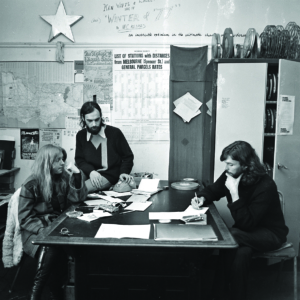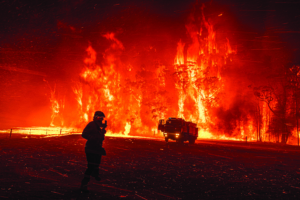It all begins with three children on a road in Iceland in 1965. From this vision in Chris Marker’s 1983 film Sans Soleil to Peter Hanlon’s 2017 ode to the iconic documentary, Atlantis, Iceland, [1]The 2017 Adelaide Film Festival program guide notes that Atlantis, Iceland is a ‘work-in-progress’; see <https://adelaidefilmfestival.org/sessions/15719> accessed 15 February 2018. the figures we see symbolise something unobtainable and ethereal, referred to by both films as ‘the image of happiness’. As the voiceover in Marker’s film recounts:
He said that […] he had tried several times to link it to other images, but it never worked. He wrote me: ‘One day, I’ll have to put it all alone at the beginning of a film, with a long piece of black leader. If they don’t see happiness in the picture, at least they’ll see the black.’
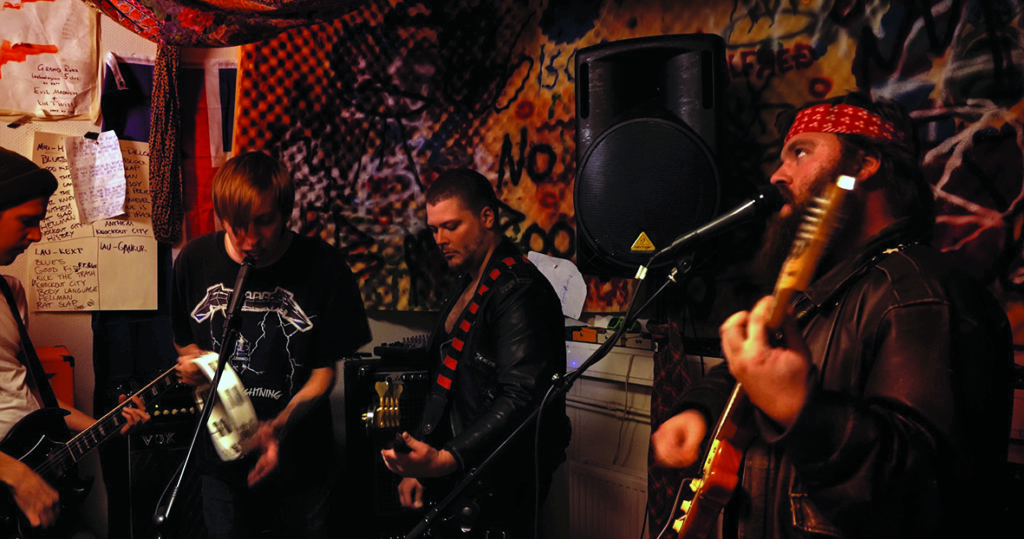
Marker’s exploration of life in the early 1980s uses footage primarily from Japan and West Africa to create a collage. A textbook example of cinema vérité, the film movement dedicated to arms-length observation as a way of engendering authenticity in people and place,[2]See Stephen Mamber, ‘Cinema Verite: Definitions and Background’, in Cinema Verite in America: Studies in Uncontrolled Documentary, MIT Press, Cambridge, MA, 1976, available at <https://mitpress.mit.edu/sites/default/files/titles/content/9780262630580_sch_0001.pdf>, accessed 13 February 2018. Sans Soleil commentates on the banalities of consumerism and expresses a desire for transparency in what drives us and in the choices we make, both as a society and as individuals.
In Atlantis, Iceland, Hanlon and his crew journey to Reykjavik in the hope of finding the three children, and to see the land they come from. They arrive in time for Iceland Airwaves and, though this renowned music festival is multi-genre, we see only the bands that draw Hanlon’s attention, primarily those that play punk or metal. The Atlantis, Iceland collage then incorporates snippets of performances and interviews with local musicians and artists; a look at the 2016 Icelandic election, which is taking place during the filmmakers’ stay; and arresting images of icy, barren landscapes.
Both films pose a quandary: at what point does cinema vérité cease to be an inquisition and become fetishisation? And in Atlantis, Iceland’s case specifically: how far can film-makers go to replicate the technique and dialogue of their influences without losing their narrative?
By looking to genres of the past to make sense of protest in the present day, the film frames dissent in a way that dismisses not only entire genres of music, but also the importance of gender, class and race to protest work now.
Both Sans Soleil and Atlantis, Iceland consist of fragments tied together by an invisible narrator. A woman’s voiceover reads letters, emails or messages from the director, all of which actively avoid using first person. ‘He told me’ or ‘he wrote’ preface many of the recollections in Atlantis, Iceland, but we are never informed of the identity of the woman Hanlon is writing to, or why he has chosen her as his confidante.
The female narrator’s anonymity speaks to a broader emphasis on masculinity throughout the film. The feminine – women, children, nature – are spiritual, untouchable, daunting. ‘Because of the isolation, maybe Icelandic people sometimes misunderstand pop music,’ says a member of all-female local act Kælan Mikla, ‘and make something weird, and not the ideal pop music.’ Elsewhere, the members of Dream Wife, an all-female British punk band, speak of the sense of community within Iceland Airwaves, their admiration at the number of women on the bill, and the juxtaposition of being in this beautiful place and playing music in dark venues. In contrast, the male bands interviewed are aggressively masculine in both appearance and tone. Pink Street Boys are lauded as ‘the loudest band in Iceland’ by the narrator, and boast that they’re ‘banned in France’: ‘We have been before in a bubblegum-psych-pop band and wanted to do some, you know, something more extreme. More rock’n’roll. More balls.’ Hanlon continues to play to gendered stereotypes in the way bands are introduced and interviewed. Kælan Mikla say, ‘We’re not musicians – we have no idea what we’re doing,’ while Sólstafir’s lead singer asserts, ‘We have been described in many strange ways. I always say we’re a non-metal heavy metal band.’
That Iceland is a country of isolation, and that isolation breeds curiosity and a sense of play, is a worthy topic for exploration, particularly when interwoven with the Icelandic election and the 2008 economic crash that informed so much of the discourse around it. However, Hanlon fails to ask the performers ‘Why punk?’ and ‘Why metal?’ – an enormous shame, given the existence of the riot grrrl movement and the history of protest within the former genre. This also means we never hear a considered view on the relationship between anarchic music and broader politics from the Icelandic musicians themselves.
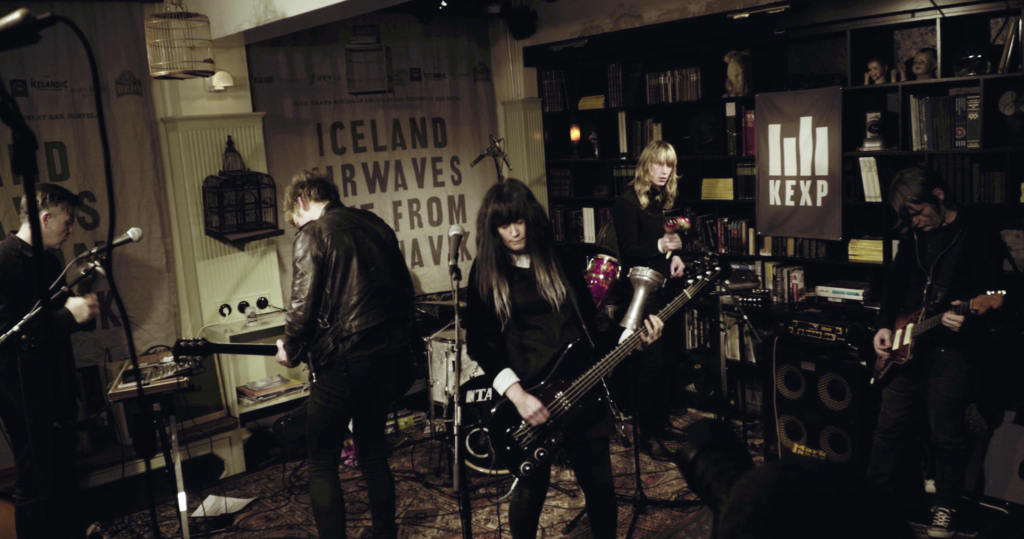
Rather than speaking of this current wave of punk and metal bands in Iceland, or indeed their connection to similar contemporary movements abroad, Hanlon exemplifies a relentless desire to mythologise the past. Bands such as The Stranglers, The Clash and Joy Division are brought up repeatedly throughout the film: ‘He really liked Icelandic music – so influenced by punk,’ the narrator tells us. ‘He was a punk purist, focusing on the UK scene from the late seventies and early eighties.’ This idea is brought home when Hanlon attends a ‘secret punk party’. Initially, we watch as invites are whispered, attendance thereby depicted as exclusive. But, in reality, the proceedings take place in what looks to be an ordinary Reykjavik square where anyone could walk past and ask what’s going on. There, Johnny Rotten speaks of punk’s glory days, spitting out anecdotes about drugs and anarchy from the 1970s.
Meanwhile, the election campaign continues. The Pirate Party are framed as the left-wing revolutionaries the country needs: ‘The fact that at times they polled as high as 40 percent [of the vote] made the Icelandic Pirates a bit of an international cause célèbre’ and, though ‘this reflected a deep distaste for politics as usual, it seemed to be an unusually moderate revulsion,’ reports a news article from the time.[3]Oddný Helgadóttir, ‘No, the Pirates Didn’t Win Iceland’s Elections. Here’s What Happened Instead.’, The Washington Post, 30 October 2016, <https://www.washingtonpost.com/news/monkey-cage/wp/2016/10/30/no-the-pirates-didnt-win-icelands-elections-heres-what-happened-instead/>, accessed 13 February 2018.
While Atlantis, Iceland was being filmed, the world was grappling with the rise of now–US President Donald Trump. At the time, music critic Jessica Hopper wrote of the ‘silverlining myth’:
In the months leading up to the presidential election, there was a glib joke that journalists, musicians, and fans would default to. The silver lining to winding up with four years of Trump and the oppression he promises, it was said, is that music will be better: Punk will rise up, or maybe pop will deflate and get “real,” gain meaning, be explicitly political […] But we need to see it for what it is at its core: It’s not a joke; it’s indifference to the plight of other people, and ignorance of the many ways a Trump presidency threatens to ruin lives.[4]Jessica Hopper, ‘The Silver-lining Myth’, MTV News, 11 November 2016, <http://www.mtv.com/news/2953786/trump-music-silver-lining-myth/>, accessed 13 February 2018.

In fact, what nostalgia for punk as the quintessential form of protest music forgets is that punk was never meant to be just music in isolation. As The Guardian’s Dorian Lynskey has asserted,
nostalgia doesn’t explain the survival of punk as a sprawling global subculture. There is something there – some irreducible core attitude – that continues to thrive even when Joe Strummer is dead and John Lydon (no longer Rotten) advertises butter.[5]Dorian Lynskey, ‘No Future? Punk Is Still the Sound of Youth Rebellion the World Over’, The Guardian, 2 June 2012, <https://www.theguardian.com/music/2012/jun/01/no-future-punk-youth-rebellion>, accessed 13 February 2018.
Although Atlantis, Iceland does manage to show what contemporary punk looks like beyond clichés – thanks, in part, to curation outside its filmmakers’ own (the film was essentially reliant on the featured festival’s producers, Iceland Music) – it never widens its scope enough to explore the music that, today, would encapsulate the subversive conception of punk. As Hopper argued:
To suggest that music is going to be “better” under this current, particular application of oppressive batshittery is also to erase a vast body of personal-political music from these past few years that explicitly confronts injustice. From Beyoncé’s Lemonade to Vince Staples’s Summertime ’06 to Helado Negro’s Private Energy to Solange’s A Seat at the Table. [6]Hopper, op. cit.
Even on Australian shores, there are plenty of comparable, though lesser known, Indigenous examples of ‘personal-political music’ that have existed outside the ‘punk’ handle for generations: Yothu Yindi and the Warumpi Band in the 1980s, A.B. Original and Electric Fields in more recent years.
In the documentary short Remembering Chris Marker (Jesse Watt, 2012), an intertitle cites Marker’s words: ‘Perhaps the only coherent part of my work is to try to give the power of speech to people who don’t have it.’[7]‘Remembering Chris Marker’, Frieze, 26 September 2012, <https://frieze.com/media/remembering-chris-marker>, accessed 15 February 2018. But, by looking at political protest in music through such a narrow lens, Hanlon dismisses his predecessor’s belief that cinema vérité affords the ultimate social narrative. By looking to genres of the past to make sense of protest in the present day, the film frames dissent in a way that dismisses not only entire genres of music, but also the importance of gender, class and race to protest work now.
‘When people suggest that punk, or rock, or music itself, will finally “start reacting,”’ wrote Hopper, ‘what is really being said is that things will be so bad that straight white people will start noticing and doing something because the floodwaters have reached their door.’[8]Hopper, op. cit. There is a danger in collages like Sans Soleil or Atlantis, Iceland whereby, instead of creating a picture, one merely brings up a reflection.
Is happiness chasing what seems unobtainable – the ends of the Earth, the ethereal, the mystery – or does it lie in the banalities of everyday life? When the search for the three children in Iceland from 1965 resumes, nearly seventy minutes into the film, it is revealed that an Icelandic news program has also been on the hunt for them (though we’re never told why it launched its investigation so long after the release of Marker’s film). We learn that they are connected to Árni Johnsen, a former politician somewhat euphemistically referred to as ‘a colourful character’. The film then cuts to an interview with Kristbjörg Sigriður Kristmundsdóttir, the only one of the three still remaining in Iceland. She has been going about her life all these years with no knowledge of Sans Soleil or her involvement in it. ‘There was a lot of filming done here,’ she recalls. ‘It’s a beautiful view.’ The narration returns:
Were they the image of happiness? They seemed happy – happy enough. He sent me an email that seemed tinged with disappointment. Árni Johnsen, the legend he’d never heard of, turned out to be the key. He should have been happy, content, satisfied. But he wasn’t. Something still eluded him. Meeting one of the girls from that image seemed to have answered nothing […] There was something else — he just didn’t know the question. He feared for something unknown.
I know nothing of Kristbjörg’s life, other than the fact she was once filmed in a field as a child, and the footage was used in two films. Two films made by men on journeys to find something they weren’t sure of. Men who had the financial means to travel across the world, to hire others to film what they saw, to hire an invisible narrator to relay their thoughts. Yet, from the five minutes of Atlantis, Iceland’s eighty-nine dedicated to Kristbjörg, it seemed, to me, that her life indeed contains far more happiness than that of either Marker or Hanlon. She appears at peace in a beautifully understated way, albeit a little overwhelmed by all this fuss. Hanlon, however, remains restless and unsatisfied to the end.
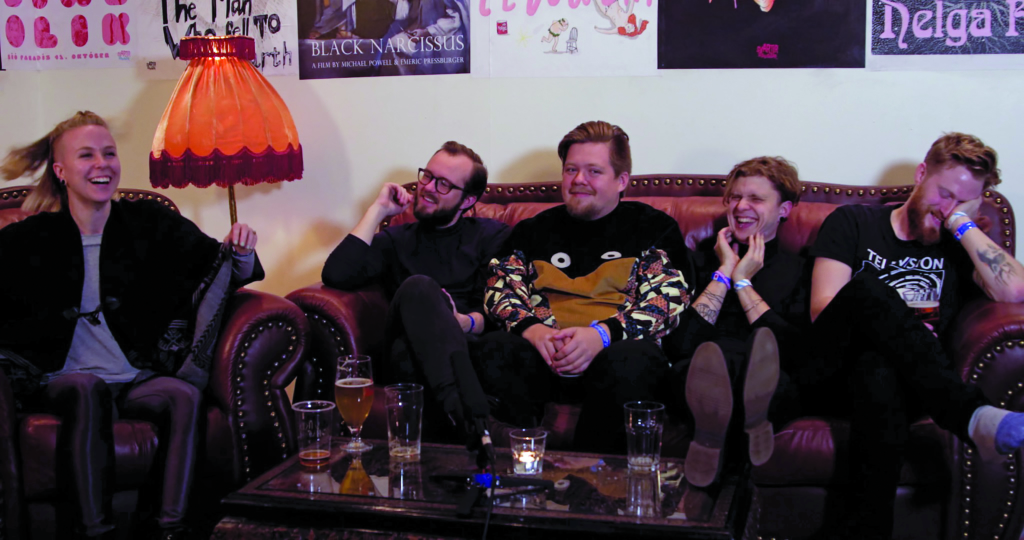
What goes unsaid is that everything he finds in Iceland – underground music, messy political movements, ethereal landscapes at the end of the Earth – is also present here in his native Australia. In his review of Marker’s film following its release in 1983, Vincent Canby described Sans Soleil as
less concerned with the quality of life on this planet than with its own desperate, much more private search. That search is for a film format into which the director can stuff all the footage from his vacation travels.[9]Vincent Canby, ‘Sans Soleil, Views of People’, The New York Times, 26 October 1983, <http://www.nytimes.com/1983/10/26/movies/film-sans-soleil-views-of-people.html>, accessed 13 February 2018.
Unfortunately, this narcissism is carried over by Hanlon into his tribute, and what we see is not a narrative of happiness but a hyperreal slide show.
In Atlantis, Iceland, Hanlon is searching for his Atlantis, a mythical place in which to find himself. What he seeks, however, is not a location but a refuge, and one that no longer exists: an island tinged with nostalgia in both music and politics, free from Trump-branded conservatism, from music deemed unintellectual due to its commercial nature and from banal consumerism. Reykjavik is not the city lost at sea that this film’s heavy-handed metaphor suggests; it is informed by history and mythology, yes, but it exists firmly in the now. Ultimately, what Hanlon seeks is a return to his youth, and, in doing so, he has made a film that is not so much a worthy exploration of a place or its people as an arrogant travelogue that ignores what makes Iceland’s people happy.
Blinded by nostalgia, unaware that the contemporary may look and sound different but is no less worthy of attention, Atlantis, Iceland sinks.
Endnotes
| 1 | The 2017 Adelaide Film Festival program guide notes that Atlantis, Iceland is a ‘work-in-progress’; see <https://adelaidefilmfestival.org/sessions/15719> accessed 15 February 2018. |
|---|---|
| 2 | See Stephen Mamber, ‘Cinema Verite: Definitions and Background’, in Cinema Verite in America: Studies in Uncontrolled Documentary, MIT Press, Cambridge, MA, 1976, available at <https://mitpress.mit.edu/sites/default/files/titles/content/9780262630580_sch_0001.pdf>, accessed 13 February 2018. |
| 3 | Oddný Helgadóttir, ‘No, the Pirates Didn’t Win Iceland’s Elections. Here’s What Happened Instead.’, The Washington Post, 30 October 2016, <https://www.washingtonpost.com/news/monkey-cage/wp/2016/10/30/no-the-pirates-didnt-win-icelands-elections-heres-what-happened-instead/>, accessed 13 February 2018. |
| 4 | Jessica Hopper, ‘The Silver-lining Myth’, MTV News, 11 November 2016, <http://www.mtv.com/news/2953786/trump-music-silver-lining-myth/>, accessed 13 February 2018. |
| 5 | Dorian Lynskey, ‘No Future? Punk Is Still the Sound of Youth Rebellion the World Over’, The Guardian, 2 June 2012, <https://www.theguardian.com/music/2012/jun/01/no-future-punk-youth-rebellion>, accessed 13 February 2018. |
| 6 | Hopper, op. cit. |
| 7 | ‘Remembering Chris Marker’, Frieze, 26 September 2012, <https://frieze.com/media/remembering-chris-marker>, accessed 15 February 2018. |
| 8 | Hopper, op. cit. |
| 9 | Vincent Canby, ‘Sans Soleil, Views of People’, The New York Times, 26 October 1983, <http://www.nytimes.com/1983/10/26/movies/film-sans-soleil-views-of-people.html>, accessed 13 February 2018. |



